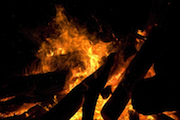I'm using the book The Anatomy of Motive by John Douglas and Mark Olshaker to create believable antagonists. My last post began a discussion on fire-starters and why it's important to understand how these violent offenders think and act, even if your bad guy isn't an arsonist. Check the previous post if you're lost.
 (Photo courtesy of freedigitalphoto.net)
(Photo courtesy of freedigitalphoto.net)
I'd like to begin with this interesting quote: "Arson, like bombing and various other forms of terrorism, is the crime of a coward. It is perpetrated by a person (typically a man) who wants to strike out but does not have the courage--or even the interpersonal skills, for that matter--to face his intended victim nose-to-nose. And in the case of arson, especially, that victim is usually a faceless, sexless cipher in his mind rather than a living, breathing human being."
When creating your fire-starting bad guy, he can't be confrontational. He'll shy away from arguments, he'll back away from heated discussions, and he probably won't stand up for himself or his decisions to those in authority over him (boss, parent, maybe even spouse). He will, however, fantasize about getting revenge. There won't be a discussion with clever words and crafty arguments. There'll just be flames. These guys are internalizers--loners, asocial misfits who puts distance between themselves and everyone else. His victims are always smaller, weaker, and more vulnerable than he is, someone who won't challenge him or seem to be on equal ground. Another way these men attack is the "blitz", where they immobilize their victim and render her unconscious quickly so he doesn't have to deal with her as a human being.
The arsonist likes to taunt authorities from afar, flaunting his superiority. They like to stick around the blaze and watch as firefighters scurry to put out the flames. Sometimes, the arsonist will stick around only long enough to see the first responders show up, then take off to set the next fire near the now-empty fire station. He gets caught up in the media attention that's focused on him. He becomes a media whore, needing to see his handiwork on the TV, in the papers, on the radio news broadcasts. When the coverage isn't enough, he escalates to killing people with his fires. He doesn't hate the people he kills--he's just getting off on the power he has over life and death. The fires have to get bigger, better, deadlier, for him to continue getting satisfaction from them.
When arsonists start out, they begin in their "comfort zone" - the area of town they feel most familiar with, close to where they work or live. They have to feel comfortable: know the escape routes, able to blend in on the streets, be close to the refuge of home or some other safe place. In this comfort zone they can talk their way out if confronted in the area. With each fire they set and get away from cleanly, their confidence builds and they slowly expand their comfort zone.
Use this in your book. Your hero will want to focus attention on the first known acts of the arsonist he's tracking, because those first ones are close to home/work, which can be helpful in narrowing down a suspect pool.
I'm not finished with arsonists, but the authors take a quick break to discuss the difference between signature and modus operandi. I want to spend the next post talking about that, then I'll (hopefully) finish the profile on arsonists.
-Sonja


No comments:
Post a Comment